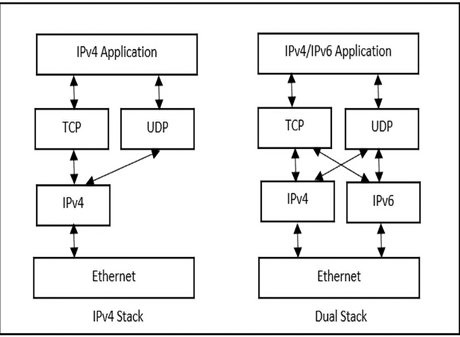Many protocols usually lie on network infrastructure, but for this book, we will be covering two of the most popular communication technologies that are based on IoT: IPv6 and RPL. In contrast to IPv6 and RPL, LoRaWAN is another prevalent communication technology in IoT, albeit operating at a different layer. LoRaWAN facilitates communication from end devices to gateways using its distinct protocol, not relying on IP.
But first, we will discuss the major differences between IPv4 and IPv6, and why IoT devices have grown to use IPv6 as opposed to IPv4.
IPv4 versus IPv6
As you may already know, IPv4 is the original version of IP, which has already been in use since the internet’s early days. It uses 32-bit addresses, which allows for a total of about 4.3 billion unique addresses. At the time, this seemed like a huge number, but the rapid growth of the internet has led to a shortage in the number of available IPv4 addresses. This is why IPv6 was introduced.
IPv6 was developed to address the issue of the exhaustion of addresses that was taking place with IPv4. By utilizing 128-bit addresses, it ensures that there is a virtually unlimited number of unique addresses. This makes IPv6 well suited for IoT as there are most likely many devices that need to be connected to the internet. It is this design consideration that gives it its main advantage over IPv4 since it is necessary to uniquely identify each device, which IPv4 would not have enough addresses to allocate to be able to do effectively and efficiently.
Another advantage of IPv6 is its support for a myriad of low-power networking technologies, such as 6LoWPAN. This makes it easier to connect to a large variety of devices on the internet, especially those with limited resources. It can also be seen that more devices are slowly starting to shift their support to only being for IPv6 as opposed to IPv4, such as Narrowband Internet of Things (NB-IoT) devices. These are devices that are based on LPWAN radio technology and utilize a subset of the LTE standard, which focuses on indoor coverage and offers low cost, high connection density, and long battery life.
Some solutions, such as utilizing a dual stack, help create a solution to support this. A dual stack is a network configuration that helps devices use both IPv4 and IPv6. This is useful to ensure that devices that use either protocol can be supported and communicated with by other devices. It is its backward compatibility with IPv4 that makes it very valuable as many devices still currently use IPv4. However, with the emergence of more IoT devices, it can still communicate with devices that are solely based on IPv6, hence allowing communication between older and newer systems. This also allows the transition to IPv6 to be smoother compared to having to directly switch everything to IPv4 all at once, especially if you are building within a production environment.
However, some disadvantages come with doing this. One disadvantage is that setting up dual stacks can be more complex and expensive. This is due to both protocols being used while having to consider all the additional resources that need to be managed. Another disadvantage is that using a dual stack would increase the size of the network, which, in turn, increases the number of addresses required, leading to additional costs for organizations. Here is an example of the difference in setup between an IPv4 stack and a dual stack:

Figure 4.3 – Setup of IPv4 stack versus dual stack
As we can see, an IPv4 stack only supports IPv4 with its communications toward the TCP and UDP layers, while a dual stack can have both protocols communicate with both layers.
Next, we will look at RPL, another popular choice of IoT-based infrastructure protocol.

